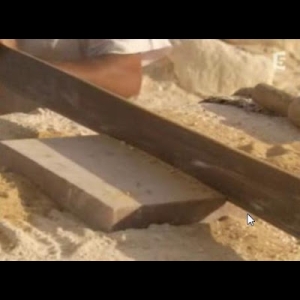♦Video♦
[Serie] Superscience
EP "La grande pyramide (2006)
12. Denys A. Stocks : Utilisation de Cuivre pour taillé la roche calcaire
Arsenic trouvé dans les alliages de cuivre Egyptien : meilleure résistance
15. Granit : Burin en Cuivre impossible
Denys A. Stocks : Scie sans dent en cuivre avec Abrasifs
♦Livre♦
Experiments in Egyptian Archaeology: Stoneworking Technology in Ancient Egypt
103. The working of stone with copper chisels and adzes, with flint chisels, punches, scrapers and adzes, and with grinding stones and stone hammers only supplied part of the craftworker’s capability to fashion all types of ancient stone artifacts. In order to enable ancient Egyptian artisans to create the range of objects demanded of them during the Late Predynastic and Dynastic periods, other technology required development. Often, modern technology evolves from earlier techniques and materials, and it is likely that such fundamental developments also occurred in ancient Egypt. Thus, two important tools for cutting the stones were added to the craftworker’s tool-kit, and these were the flat-ended copper tubular drill and the flat-edged copper saw, both used with a particulate abrasive. The tubular drill predated the invention of the stonecutting saw, which probably owed its development to the introduction of hard stone for architecture in the Early Dynastic and Old Kingdom periods. The stonecutting saw is a direct development of the serrated woodcutting saw, itself a development from the serrated flint knife and sickle. No examples of copper stonecutting tubes and saws have survived to the present day, nor have any tomb representations of them been found.
106. The normal stroke of a saw is approximately 30 cm, similar to the distance a bow-shaft travels when rotating a tubular drill: this is, of course, directly related to the reciprocating (to and fro) motion of the hand, a function of the arm’s movement at its elbow and shoulder joints. Petrie located saw-slots in stone objects, and these showed that the saw thicknesses varied from 0.03 to 0.2 inch11 (1–5 mm). Stonecutting saws were also in use on the Third Dynasty calcite sarcophagus of Sekhemkhet,12 on the back of one of the triads of Menkaure,13 and on stone blocks from the Fifth Dynasty pyramid complex of Nyuserre.14 In order roughly to shape statuary, waste pieces were often sawn from the stone blocks.15
130. Long parallel striations of varying depths and widths, similar to those seen in ancient stone objects, were visible on the sides and the bottom of the slot, and upon the saw’s individual flat edges between the notches. There was extensive pitting to the sides of the saw, also seen in the subsequent dry sawing test. In both the wet and the dry tests, the extra granite abraded to form the V-shape has been disregarded when calculating the cutting rate. It was noticeable that the sand had to be kept fluid; drying-out sand rapidly increased an already significant effort to move the saw. The used sand powder slurry poured over each end of the slot, its copper content largely washed away into the ground below.
134. The experimental sawings of the rose granite with the wet and dry sand abrasive indicate that the stone was cut at roughly equal rates. However, there is no requirement for a stonecutting saw to be notched, or serrated like a wood saw. In fact, notches66 and serrations are counter-productive to sawing with a loose abrasive, wet or dry. Any copper removed to notch the saw is wasted, reducing the area of the cutting edge. The wooden frame is unnecessary to place tension on such a rigid blade, and in a tall block of stone the frame eventually limits the depth to which the saw can cut. However, stone weights at either end allow a saw to cut through the stone without restriction.

